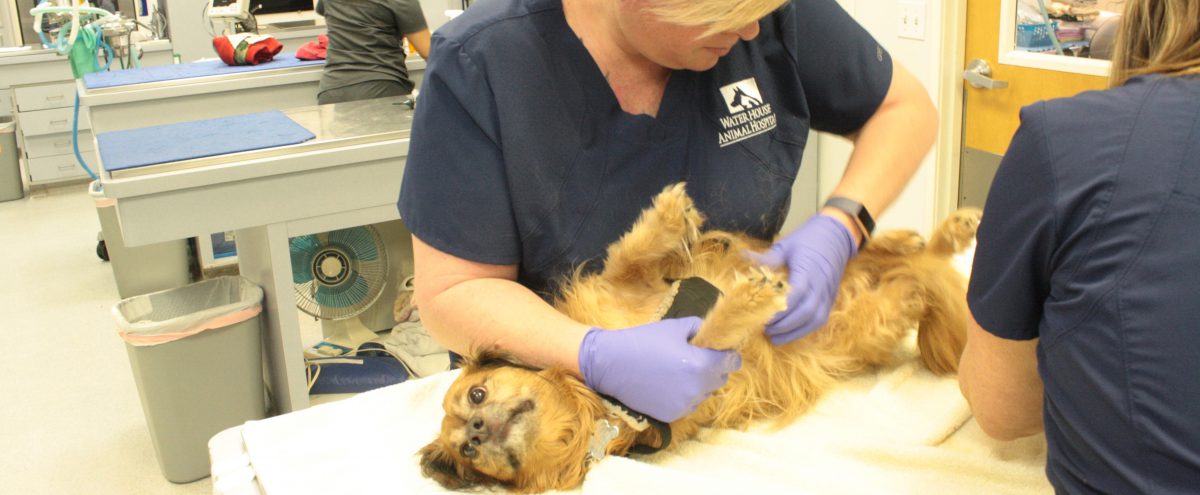Pet insurance on the rise

Doreen Bishop inserts a urinary catheter into Sparky. Photo by Donald Promnitz.
Is your pet covered?
While it may have seemed outlandish not long ago, there’s actually a growing demand for pet insurance policies in the U.S. as pets become seen less as mere animals and more as part of the family.
According to the North American Pet Insurance Association trade group, there were more than 1.8 million dogs and cats insured in the U.S., and market research firm Packaged Facts projects that the industry will double to $2 billion in the next three years. The information was relayed last year in a report by Today’s Veterinary Business.
It’s also meant a great deal of business for the Seattle-based company Trupanion. Over the last five years, they’ve seen more than 80,000 claims for cancer, resulting in more than $34 million in reimbursements. For the most part, companies offer their policies exclusively for dogs and cats, though some do offer plans for exotic pets. T.J. Houk, chief data officer and chief member experience officer for Trupanion, said that the company’s stock has grown in the range of 20 to 30 percent over the nine years that he’s been there.
While the trend has been popular for some time in the U.K., Americans were slower to pick up on the concept until the quality of plans themselves began to improve over the last decade. Previously plans tended to have caps and limits, many of which hindered veterinarians. However, as the demand for better pet care came about, so too did better policies.
“And so that was one of the things that Trupanion and a number of other companies started providing — richer, higher quality plans — and that’s what’s really got the growth to start up again in the U.S.,” Houk said. “So we are far from the penetration levels that folks see in the U.K., but it’s certainly gaining traction within the U.S.”
These improved insurance policies have also given veterinarians the ability to provide better care for pets in the form of treatments one might associate exclusively with humans. In Fresno, veterinarian Cheryl Waterhouse provides exactly this kind of care. This includes bringing in specialists for dentistry, surgery, laser therapy and cardiology. Waterhouse Animal Hospital is the only veterinary clinic in the Valley to provide this volume of care, and said plans have the ability to mitigate expenses.
“I know clients of mine who have gone to UC Davis to seek specialist care — especially neurology and things like that—and they can spend $10,000,” Waterhouse said. “And so the pet health insurance obviously comes in handy when you’re looking at these huge bills.
Still, the overall number of insured clients Waterhouse has is relatively low — with her estimating it to be in the range of 2 to 5 percent. However, she says she’s made it a policy to advise the owners of new pets to consider a policy before there are pre-existing conditions.
According to Waterhouse, prices for policies can vary significantly, just as they do for humans. Variables like location, age and preexisting conditions are weighed and considered by companies when calculating a plan. Another major factor taken into consideration is the breed of the pet. Healthier breeds like Shih Tzus and Havanese tend to be fairly cheap. Meanwhile, the policy for a French bulldog — which is commonly plagued with back, heart and breathing problems — could set an owner back as much as $100 per month.
ValuePenguin, Inc., a company that provides insurance data, lists the Irish Wolfhound, Caucasian Ovcharka, Bernese Mountain Dog, English Bulldog and Great Dane (which can be 63 percent more expensive than the average dog), are the most expensive breeds to insure.
Despite the costs, Houk said the monthly premiums are still nothing compared to a large bill for treatment, as it merely serves as a budgeting tool in the same way any other form of insurance is used. And as attitudes change in how many owners view pets (with Waterhouse describing it as going from the “barnyard to the bedroom”), the decision to purchase policies becomes an obvious choice for many.
This has also largely been a trend for millennials, as younger generations often opt to start families at a later age. A recent study by IDEXX Laboratories, Inc., a veterinary product company, found that 61 percent of millennials are willing to make financial tradeoffs to care for their pets’ health. This is 4 percent higher than their Generation X parents.
“For someone who has a pet, but doesn’t have children, there’s an extra level of responsibility that they feel given that maybe they have one animal that they’re really taking care of, is a member of their family essentially,” Houk said. “And so that does maybe play in a bit more to the interest in insurance for their pets.”
The U.S. is still far from reaching the same amount of coverage from the U.K., but in recent years, there has been significant catch up. And in the process, it’s led to good business for companies and veterinarians — and happier pets.








